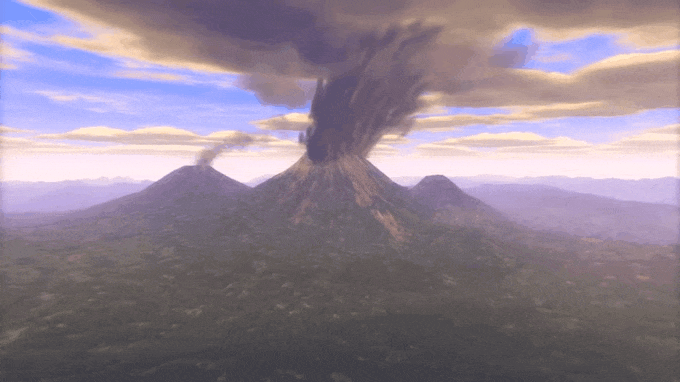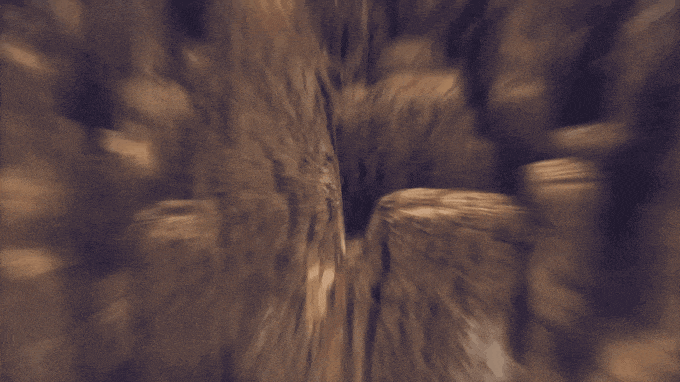|
NPS / Karen Ceballos When visitors come to Florissant Fossil Beds National Monument, the main fossils they see are some of the world's largest (by diameter) petrified tree stumps of Redwood (Sequoia Affinis) trees. The story behind these stumps of stone began 34 million years ago when a nearby volcanic complex created giant mudflows called lahars. Lahars form when volcanic ash erupts from a volcano and mixes with heavy rainfall to create a fast moving "slurry". The lahars from the ancient Guffey volcanic center buried the trees of the ancient forest in a 15-foot thick layer. 
NPS
As the trunks of the trees remained buried, the exposed parts of the trees rotted away over time. Through a process called permineralization or petrification, groundwater slowly seeped through carrying minerals such as silica from the volcanic ash that filled the open spaces of the tree such as their cells. This process can take hundreds or thousands of years and is a type of fossilization.

NPS 
NPS / Astrid Garcia Ongoing research is being conducted that will help with the conservation of the petrified stumps. Park paleontology staff are working with stone conservators from the University of Pennsylvania to monitor the environmental conditions of the area. Weather stations with a time-lapse camera are set-up next to an exposed petrified stump and one beneath a metal roof stump shelter, as pictured here. Physical threats to the stumps such as local and rock temperature, relative humidity, wind speed, wind direction, amount of rainfall and snow, sunlight, and soil moisture are all being measured. Using the data collected, a conservation plan will be developed to stabilize loose pieces of petrified wood to protect these stumps.
Another method of documenting how much these stumps are eroding away is through a technique called photogrammetry, which uses photography to create 3D models of the photographed object. Read the article below to learn more about this technique and see a 3D model of the fossilized Redwood Trio.
Want to see what these stumps look like? Watch the video below to take a virtual tour of the petrified Redwood trees located behind the Visitor Center.
Transcript
Welcome to Florissant Fossil Beds National Monument. Join us for a virtual tour of an outdoor exhibit featuring some of the largest petrified tree stumps in the world.
We will start our tour by walking through the front doors of the visitor center, you see here, and right out on to the back patio. Here we are on the back patio of the visitor center looking north at the Florissant valley. Let’s continue down this sidewalk towards those large green metal roof shelters to see the stumps. We’ve arrived at the first shelter and are looking at a petrified tree stump of a redwood tree. Let’s walk around this shelter towards that bench you see and take another look. Here’s another view of the same stump looking north at the Florissant valley. Florissant Fossil Beds National Monument protects some of the largest petrified tree stumps in the world (by diameter) like the 13.5 foot-wide one pictured here. Often, upon viewing these massive petrified redwood trees, many visitors ask “Redwoods in Colorado?” As it turns out, redwood trees once lived across most of the Northern Hemisphere but you would have to travel back millions to tens of millions of years to see that. This map of the world depicts the range of redwood trees during the geologic past with a green band extending from the western edge of North America, across the Northern Hemisphere to Greenland, Europe, and Asia. Another question people ask when they see these stumps of stone is, how did they turn into solid rock? To answer that question, let’s take a look at some artwork that reconstructs the ancient environment and geologic events that occurred here when these trees were growing 34 million years ago during a time known as the Eocene. This artwork shows what the area may have looked 34 million years ago. Here we see a stream winding through a hardwood forest, with towering redwood trees, and interesting animals like the Brontothere – a massive, 8 – 10 foot tall, two horned mammal. Near the Brontothere are miniature horses called Mesohippus. About 18 miles to the southwest of the ancient stream valley there once existed a volcanic complex, an area of multiple related volcanic vents as depicted in the background of this artwork. At one point, a large amount of volcanic ash from an eruption mixed with rainwater and/or snow melt to create a giant lahar, or volcanic mudflow, that buried the area. This artwork shows the massive, 15-20 foot tall, gray-colored lahar, moving through the ancient stream valley. The trees were left buried in mud 15 feet thick. The lahar eventually turned to stone. The top parts of the trees died and decayed. The stumps of the trees remained buried and decayed slowly which provided an opportunity for the process of fossilization to occur. This artwork shows the magnified cross section of a buried petrified stump down to the cellular level. The blue arrows represent ground water that penetrated the buried redwood stumps. The ground water in that area was rich in the mineral silica from dissolved volcanic rock. Over time, the minerals in the water were deposited in the cell spaces within the tree petrifying it through a process called permineralization. Let’s turn right now and head on over to the second shelter. Here we are looking down at some unique fossils under the second shelter. This is the world’s only known petrified trio of redwood stumps. Here’s another view of the petrified trio. You might notice that these three stumps are actually all connected… and they are. As it turns out redwood trees can reproduce though a process called stump sprouting. A redwood tree can create cloned sprouts out of its own root system. And just on the other side of the trio we see this large stump which is about 12 feet wide and over 10 feet tall. You may have noticed that many of the stumps have metal banding around them. The banding is part of an effort to help conserve and stabilize the trees which are still prone to deterioration through processes like freezing and thawing. It is believed that these trees were excavated using dynamite in the early 20th century when the area was privately owned. The excavation of the trees using dynamite caused large horizontal cracking. When the area was privately owned, guests were allowed to collect and buy petrified wood…and in one case a whole stump! Here is a stump that USED TO BE located near the trio and is now located in Disneyland Park in Anaheim California! As mentioned before, previous to being a National Park unit, this area was a privately owned tourist site that sold fossil wood for souvenirs. First, it was known as the New Petrified Forest and later the Henderson Petrified Forest and finally the Pike Petrified Forest. In 1956, 12 year old tour guide Toby Wells encountered a visitor, who asked to buy a whole stump! It turned out to be Walt Disney who ultimately transported to Disneyland Park. Since, 1969, these fossil stumps and all other natural and cultural resources within the Monument have been and continue to be protected by the National Park Service. And finally, a bonus stump! This stump is not actually under the two metal roof shelters it’s located nearby on the ½ mile Ponderosa Loop Trail and this stump is unique as it exhibits a modern pine tree growing out of a 34 million year old petrified redwood. Well, we’ve reached the end of the tour, we hope you enjoyed it.
Visit our keyboard shortcuts docs for details
Join us for a virtual tour of some of the biggest petrified tree stumps on the Earth (by diameter). This virtual tour takes you behind the visitor center at Florissant Fossil Beds to an outdoor exhibit area. Now that you've learned about how the ancient Sequoia stumps became petrified, you can continue on with your adventure. Where to next? |
Last updated: July 2, 2021

